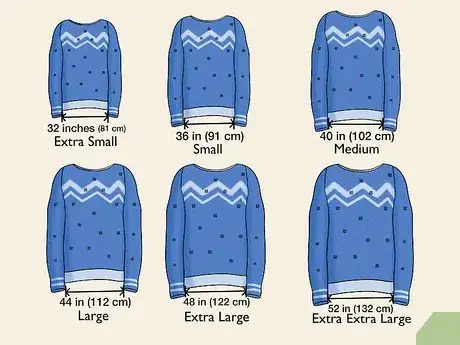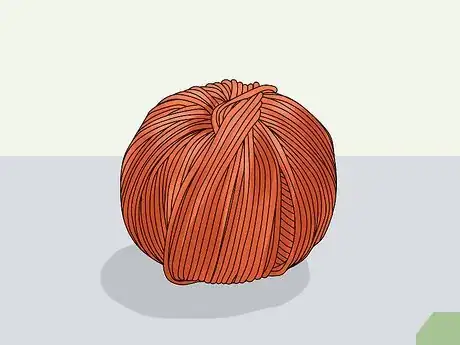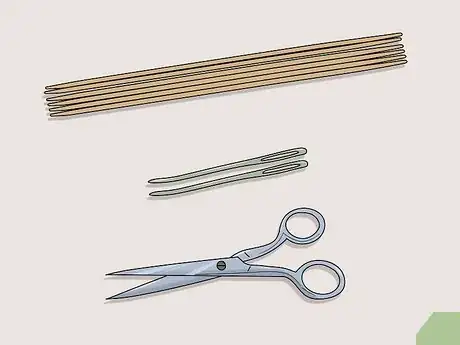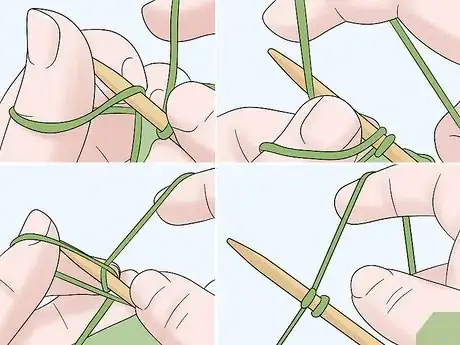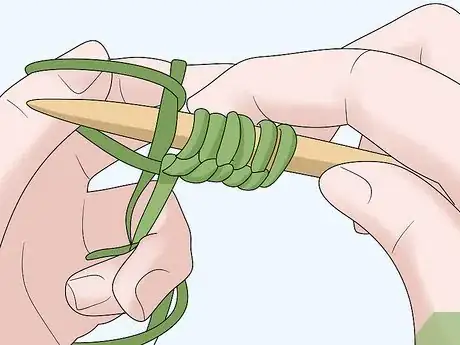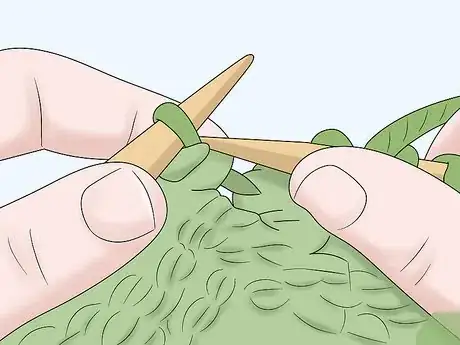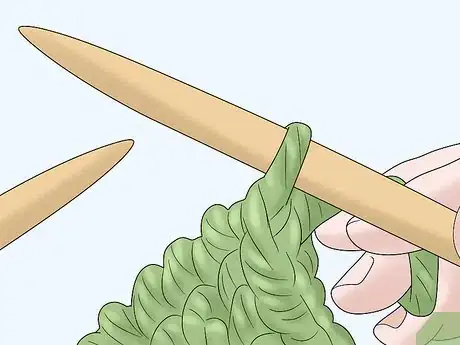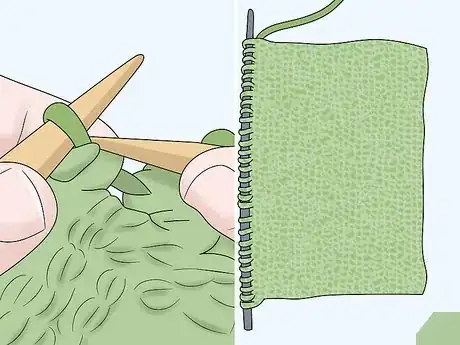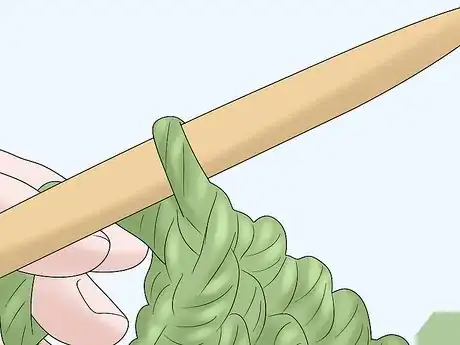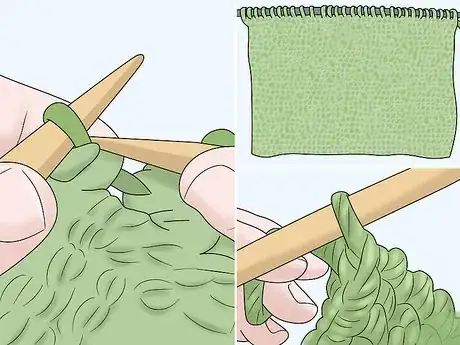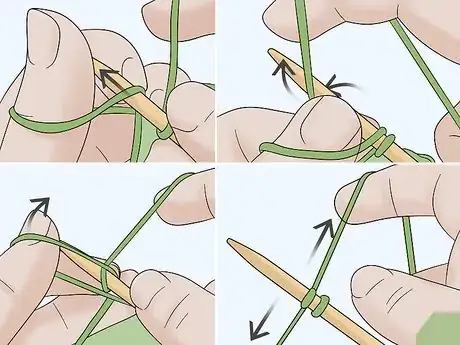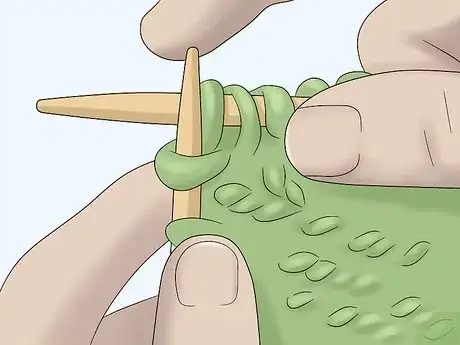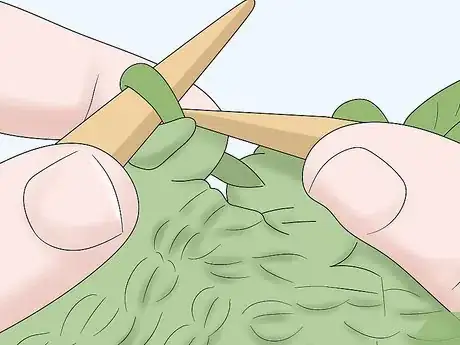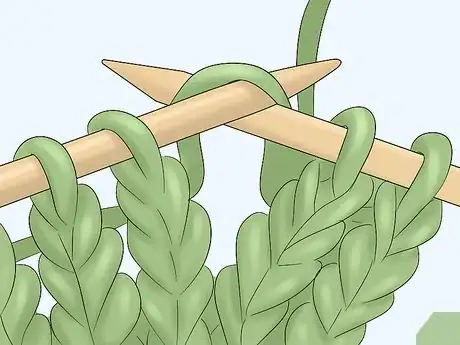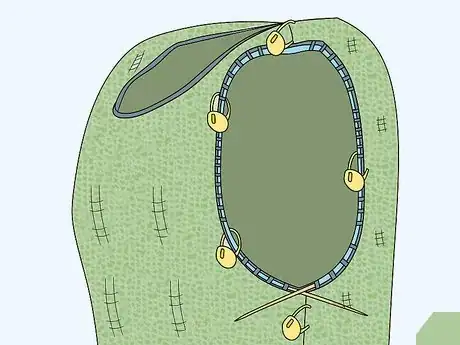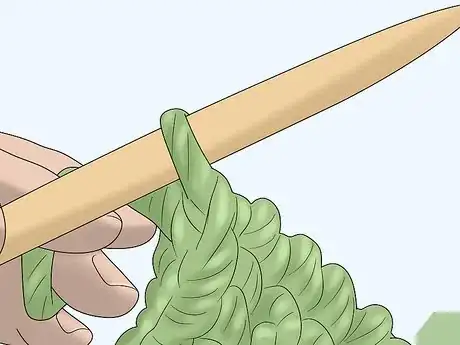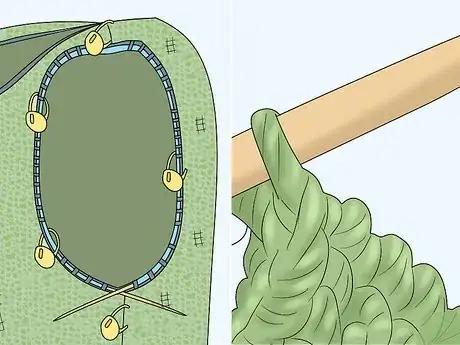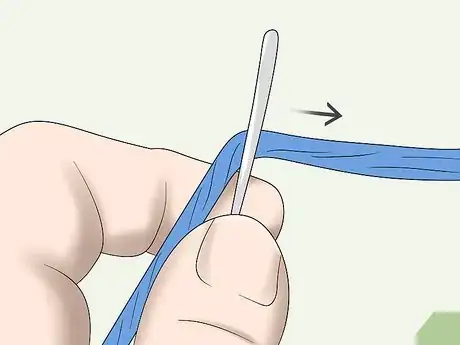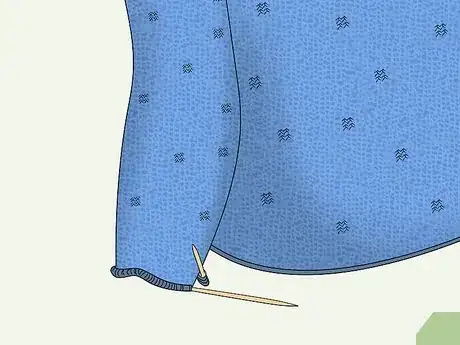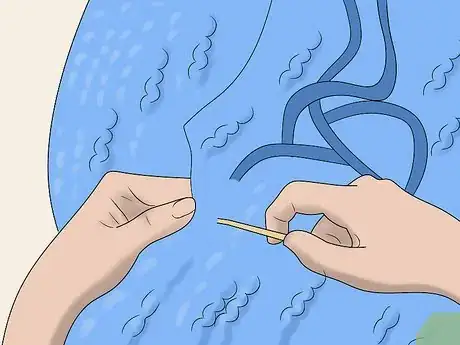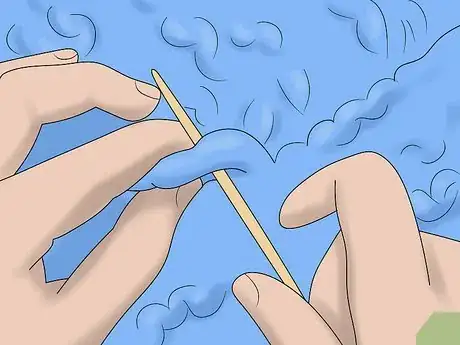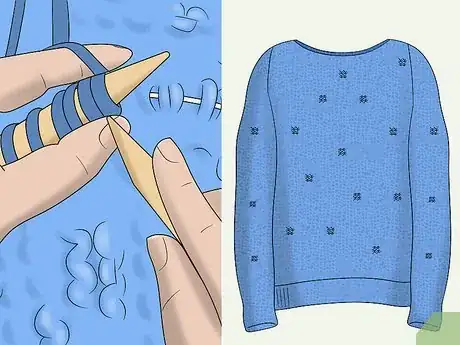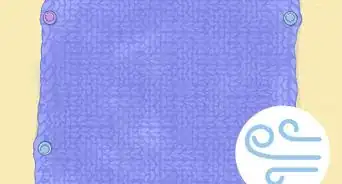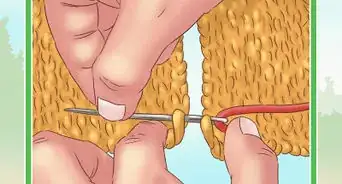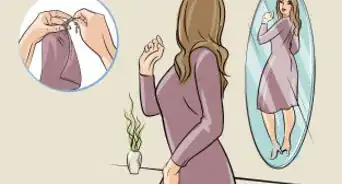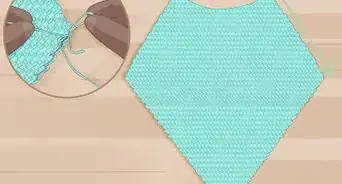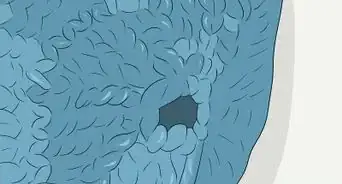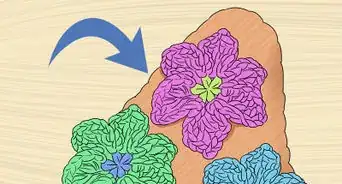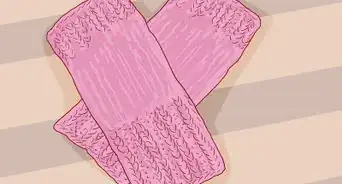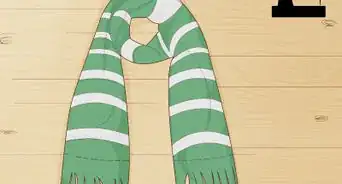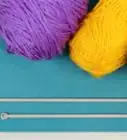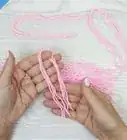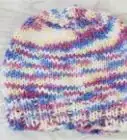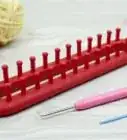This article was co-authored by Jen Webber. Jen Webber is a Knitting Specialist and the Manager of The Quarter Stitch, a crafting store based in the French Quarter of New Orleans, Louisiana. With over 17 years of knitting and crafting experience, Jen helps educate customers and the public on best knitting practices for their DIY projects.
There are 8 references cited in this article, which can be found at the bottom of the page.
wikiHow marks an article as reader-approved once it receives enough positive feedback. In this case, 85% of readers who voted found the article helpful, earning it our reader-approved status.
This article has been viewed 290,223 times.
Knitting a sweater can be a daunting project for someone who is just beginning to knit. However, it is much easier than it might seem. You can knit a sweater by following a very basic pattern. After you feel more comfortable with this basic sweater pattern, you might have the confidence to try more advanced patterns in the future.
Things You Should Know
- How to Knit the Knit Stitch
- How to Knit the Purl Stitch
- How to Count Knitting Rows
Steps
Choosing Your Size and Gathering Materials
-
1Determine your size. The number of stitches you cast on and work for each of the sweater’s sections will depend on the size you need. Measure your chest and use this measurement to choose your size. The measurements for sizes of this sweater include:[1]
- Extra Small: 32 inches (81 cm)
- Small: 36 inches (91 cm)
- Medium: 40 inches (102 cm)
- Large: 44 inches (112 cm)
- Extra Large: 48 inches (122 cm)
- Extra Extra Large: 52 inches (132 cm)
-
2Get plenty of yarn. After you have determined your size, you will be able to purchase your yarn. The amount of yarn you will need will depend on the size sweater you want to make.[2] Choose a bulky weight yarn to make your sweater, such as Lion Brand Homespun.[3] Check your size to find out how many skeins you will need.[4]
- Extra Small: 3 skeins
- Small: 4 skeins
- Medium: 4 skeins
- Large: 5 skeins
- Extra Large: 5 skeins
- Extra Extra Large: 5 skeins
Advertisement -
3
Creating the Front and Back Pieces of the Sweater
-
1Cast on the required number of stitches for your size. Start by casting on the number of stitches that corresponds to your size. This will be the same for your front and back pieces. Use your size 8 needles to cast on the stitches. Depending on your size, you will need to cast on:[9]
- Extra Small: 56 stitches
- Small: 63 stitches
- Medium: 70 stitches
- Large: 77 stitches
- Extra Large: 84 stitches
- Extra Extra Large: 91 stitches
-
2Use your size 8 needles to work the next six rows in garter stitch. After you finish casting on the required number of stitches for your size, begin working in the garter stitch. Continue working in the garter stitch for the next six rows. This will form the bottom border of your sweater.[10]
- To work the garter stitch, knit all of your rows.[11]
-
3Switch to your size 10 needles and work in the stockinette stitch. After you finish your sixth row, begin working your next row onto your size 10 needles. Then, start working the rows in the stockinette stitch. Continue to work your rows in the stockinette stitch until your piece measures 15 inches (38 cm).[12]
- To work the stockinette stitch, alternate between knitting and purling your rows. For example, you would knit the first row, then purl the second row, then knit the third row, and so on.[13]
-
4Bind off first four stitches of the next two rows. After your piece reaches 15 inches (38 cm), you will need to begin shaping the area for your armhole. To do this, bind off the first four stitches at the beginning of your next two rows. This will leave you with four bound off stitches on either side of your back piece.
- To bind off, knit the first two stitches in the row, and then loop the first stitch over the second stitch. Then knit one, and loop the first one over the second one. Continue to knit one and loop the first over the second until you have bound off the first 4 stitches in the row.[14]
-
5Work in stockinette stitch until the piece is the desired length. After binding off the stitches for shaping the armholes, your will continue working the piece in stockinette stitch. Keep going until the piece is the right measurement for your size, which includes:[15]
- Extra Small: 21 (53 cm)
- Small: 21.5 (54.5 cm)
- Medium: 22 (56 cm)
- Large: 22.5 (57.5 cm)
- Extra Large: 23 (59 cm)
- Extra Extra Large: 23.5 (60.5 cm)
-
6
-
7Repeat for the second piece. Remember that front and back pieces of this sweater will be identical, so you need to make two of these pieces. After you finish making one, repeat the process and make the other piece.
Making the Sleeves
-
1Cast on using your size 8 needles. To start each of your sleeves, you will need to cast on the right number of stitches for your size. Find your size to determine how many stitches to cast on.[17]
- Extra Small: 31 stitches
- Small: 32 stitches
- Medium: 34 stitches
- Large: 35 stitches
- Extra Large: 37 stitches
- Extra Extra Large: 38 stitches
-
2Knit six rows using size 8 needles for the sleeve borders. Use your size 8 needles to work the first six rows of the sleeve in the garter stitch. This will form the border for your sleeves.[18]
-
3Switch to size 10 needles and stockinette stitch. After your sixth row, switch your needles to the size 10 pair. Then, begin working the rows in the stockinette stitch.[19]
-
4Work your increases. You will need to work increases as you continue to knit the sleeve. This will ensure that the sleeve will get larger as you work up towards the shoulder. Begin working increases when your sleeve is about 30 rows in total. Then, work an increase into the edge stitch every four rows as you make your way up to the shoulder.
- To increase, knit into the stitch as usual, but do not slip the old stitch off the needle yet. Knit into the same stitch again by inserting the needle through the back of the stitch instead of through the front of the stitch. Then allow the old stitch to slide off as the two new stitches replace it.[20]
-
5Continue working the rows of your sweater sleeve. Keep going until your sleeve is the required measurement for your size. The sleeve size measurements include:[21]
- Extra Small: 18.5 inches (47 cm)
- Small: 19 inches (48 cm)
- Medium: 19.5 inches (49.5 cm)
- Large: 20 inches (51 cm)
- Extra Large: 20.5 inches (52 cm)
- Extra Extra Large: 21 inches (53 cm)
-
6Bind off the stitches. When your sleeve is the desired length, you will need to bind off the stitches. This will secure them so that you can sew the sleeves onto the front and back pieces.
-
7Repeat to create your second sleeve. After you finish one sleeve, make sure to make a second one. Make your second sleeve exactly the same way as the first one.
Assembling Your Sweater
-
1Thread your yarn needle. Start by threading your yarn needle with about an arm’s length of thread (around 18 inches). This will help to ensure that the yarn will not get tangled as you sew. Make sure to use the same color and type of yarn that you used for your sweater pieces.
- Keep in mind that you will need to rethread the needle before sewing each piece of the sweater, so have some yarn ready to go.
-
2Sew the sleeves closed. Line up the edges of one of your sleeves so that the right sides are facing each other and the long edges are even. Sew from the bottom corner of the sleeve near the six row border to the end of the edge near the shoulder. Then, tie off the yarn and cut any excess yarn. Leave the sleeves turned wrong side out for now.[22]
- Repeat this for both sleeves.
-
3Sew together the front and back pieces of the sweater. Line up the two pieces of your sweater so that the right sides are facing each other and the edges are even. Remember that these should be identical pieces, so lining up the edges should be easy. Then, begin sewing from the bottom corner of the sweater on the edge of the six row border you created and up towards the top. Stop sewing when you reach the armhole space.[23]
- Repeat this for both sides of the sweater.
- Leave the piece turned inside out for now.
-
4Attach the sleeves. After you have finished sewing up the sleeves and sides of the sweater, you will need to attach the sleeves to the shoulder area of the sweater body pieces. Take one of the sleeves and line it up so that the seam is facing downwards. Begin sewing where the seam of the sleeve and the seam of the body piece meet. This will be in the armpit area. Sew around the sleeve edge to attach the sleeve and close up the armhole.[24]
- Repeat this for both sleeves.
-
5Sew up the shoulders to shape the neckline. To complete your sweater, you will need to sew along the top of each of the shoulders to shape them and create the neckline. Sew along the edges of the front and back pieces of the shoulder to connect them.[25]
- Make sure to do this while the sweater is still turned inside out.
- Be careful not to make the neck opening too small or you may not be able to get the sweater over your head.
- After you finish sewing the shoulders and shaping the neckline, tie off the thread and cut the excess. Then, turn the sweater inside out to hide the seams. Your sweater is complete!
Community Q&A
-
QuestionWhat if I want my sweater to be a bit loose, especially in the arms, and I also want to make it a turtleneck?
 SarshanCommunity AnswerIf you want your sweater to be a bit loose, try making it in the next size up according to the pattern. To make it a turtleneck, simply pick-up stitches around the neck-hole, and knit to the desired length.
SarshanCommunity AnswerIf you want your sweater to be a bit loose, try making it in the next size up according to the pattern. To make it a turtleneck, simply pick-up stitches around the neck-hole, and knit to the desired length. -
QuestionHow do I gauge my sweater?
 Community AnswerKnit a swatch in the gauge of your pattern with the needles you intend to use for your project. Bind off and then wash and dry the swatch as you intend to do with the finished sweater. Finally, count the number of stitches or rows in the swatch to see if you match the gauge given in the pattern.
Community AnswerKnit a swatch in the gauge of your pattern with the needles you intend to use for your project. Bind off and then wash and dry the swatch as you intend to do with the finished sweater. Finally, count the number of stitches or rows in the swatch to see if you match the gauge given in the pattern. -
QuestionWhat does "at the same time" mean in knitting?
 Community AnswerWhile you're working on the instructions before, also follow the next ones.
Community AnswerWhile you're working on the instructions before, also follow the next ones.
Things You’ll Need
- Yarn
- Size 10 knitting needles
- Size 8 knitting needles
- Yarn needle
- Scissors
References
- ↑ https://web.archive.org/web/20211004165918/https://www.bhg.com/crafts/knitting/wearables/a-basic-knitted-sweater/
- ↑ Jen Webber. Knitting Specialist. Expert Interview. 4 August 2020.
- ↑ https://yarnsub.com/yarns/lion_brand/homespun
- ↑ https://web.archive.org/web/20211004165918/https://www.bhg.com/crafts/knitting/wearables/a-basic-knitted-sweater/
- ↑ Jen Webber. Knitting Specialist. Expert Interview. 4 August 2020.
- ↑ https://web.archive.org/web/20211004165918/https://www.bhg.com/crafts/knitting/wearables/a-basic-knitted-sweater/
- ↑ https://sheepandstitch.com/library/knitting-needle-sizes-conversion-chart/
- ↑ https://sheepandstitch.com/library/knitting-needle-sizes-conversion-chart/
- ↑ https://web.archive.org/web/20211004165918/https://www.bhg.com/crafts/knitting/wearables/a-basic-knitted-sweater/
- ↑ https://web.archive.org/web/20211004165918/https://www.bhg.com/crafts/knitting/wearables/a-basic-knitted-sweater/
- ↑ http://newstitchaday.com/garter-stitch/
- ↑ https://web.archive.org/web/20211004165918/https://www.bhg.com/crafts/knitting/wearables/a-basic-knitted-sweater/
- ↑ http://newstitchaday.com/knitting-101-how-to-knit-the-stockinette-stitch-for-beginners/
- ↑ https://www.craftsy.com/blog/2016/10/how-to-bind-off/
- ↑ https://web.archive.org/web/20211004165918/https://www.bhg.com/crafts/knitting/wearables/a-basic-knitted-sweater/
- ↑ https://web.archive.org/web/20211004165918/https://www.bhg.com/crafts/knitting/wearables/a-basic-knitted-sweater/
- ↑ https://web.archive.org/web/20211004165918/https://www.bhg.com/crafts/knitting/wearables/a-basic-knitted-sweater/
- ↑ https://web.archive.org/web/20211004165918/https://www.bhg.com/crafts/knitting/wearables/a-basic-knitted-sweater/
- ↑ https://web.archive.org/web/20211004165918/https://www.bhg.com/crafts/knitting/wearables/a-basic-knitted-sweater/
- ↑ https://www.craftyarncouncil.com/mar06_increasing.html
- ↑ https://web.archive.org/web/20211004165918/https://www.bhg.com/crafts/knitting/wearables/a-basic-knitted-sweater/
- ↑ https://web.archive.org/web/20211004165918/https://www.bhg.com/crafts/knitting/wearables/a-basic-knitted-sweater/
- ↑ https://web.archive.org/web/20211004165918/https://www.bhg.com/crafts/knitting/wearables/a-basic-knitted-sweater/
- ↑ https://web.archive.org/web/20211004165918/https://www.bhg.com/crafts/knitting/wearables/a-basic-knitted-sweater/
- ↑ https://web.archive.org/web/20211004165918/https://www.bhg.com/crafts/knitting/wearables/a-basic-knitted-sweater/
About This Article
To knit a sweater, you’ll need between 3 and 5 skeins of yarn, size 10 knitting needles, size 8 knitting needles, scissors, and a yarn needle. Start by casting the number of stitches for the size of your sweater using the size 8 needles. For example, you’ll need 63 stitches for a small sweater, 70 for a medium, and 77 for a large. Once you’ve casted your stitches, begin working in the garter stitch, which will form the bottom border of your sweater. After you finish your 6th row, start working with your size 10 needles and switch to the stockinette stitch. To do this stitch, alternate between knitting and purling your rows. Once the sweater is the length you want, bind off the stitches. Repeat this process twice, so you have both a front and back piece for the sweater. To make the sleeves, cast 32 stitches for a small, 34 for a medium, or 35 for a large. Knit 6 rows using size 8 needles and the garter stitch. Then, switch to size 10 needles and the stockinette stitch. When your sleeve is at 30 rows, work in an increase into the edge stitch every 4 rows to make room for the shoulder. Once your sleeve is long enough, bind off the stitches. Finally, use your knitting needle and yarn to assemble all your pieces together. For more advice, like how to shape the neckline of your sweater, read on!
